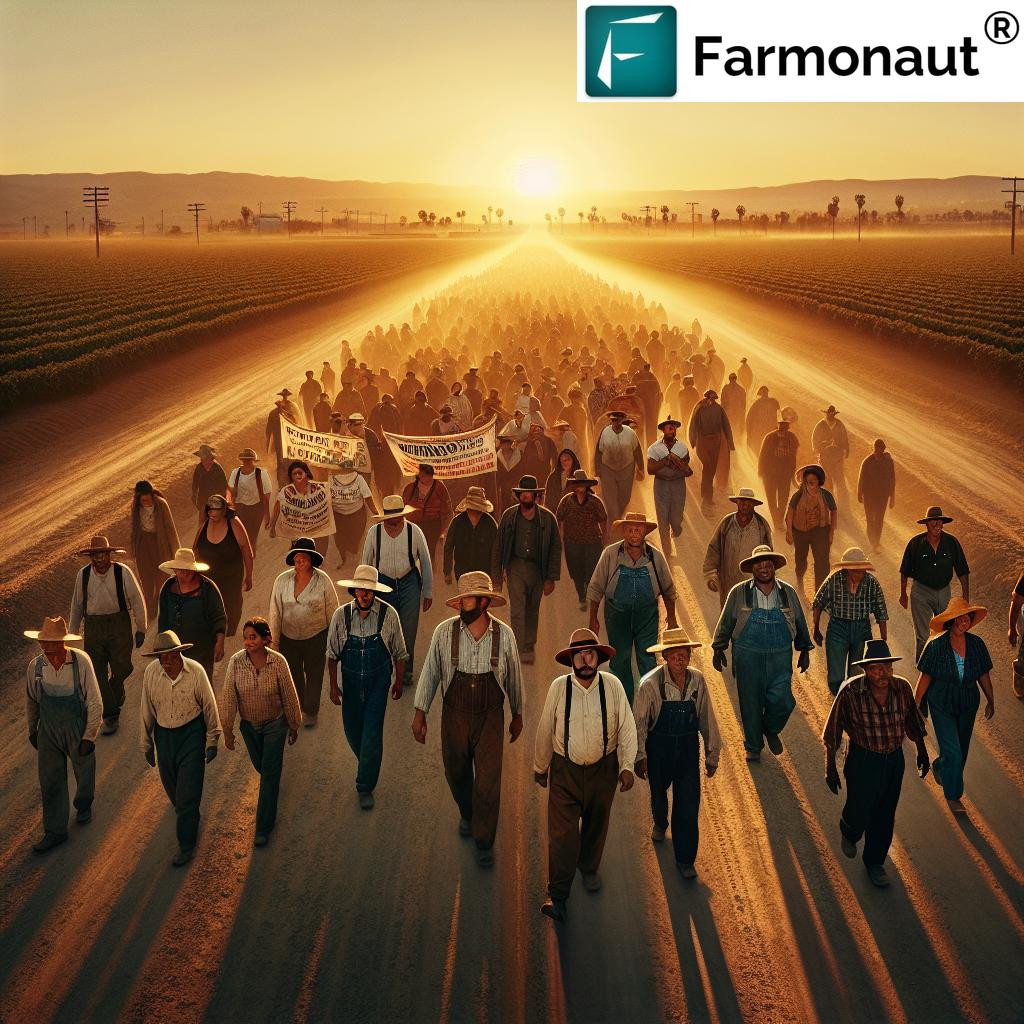From Delano to Brawley: The Evolving Legacy of California’s Farmworker Rights Movement
“The 1965-1970 Delano grape strike and boycott involved over 10,000 farmworkers, leading to significant labor reforms in California agriculture.”
As we delve into the rich history of farmworker rights and labor movement in California, we find ourselves on a journey that spans decades, from the sun-drenched fields of Delano to the bustling streets of Brawley. This exploration of agricultural labor laws, farmworker strikes, and the enduring legacy of nonviolent resistance in agriculture not only commemorates the past but also sheds light on the ongoing challenges in farm labor conditions.
Our story begins in the 1960s, a pivotal era for civil rights in agriculture, and extends to the present day, where community marches and rallies continue to honor this legacy while addressing current issues in the agricultural industry. We’ll examine the impact of the grape boycott, the contributions of Filipino farmworkers, and the complexities of union organizing in farming. Through this narrative, we’ll gain insights into the evolving story of farmworker advocacy and the ongoing struggle for fair wages, better working conditions, and labor protections in the fields.
The Seeds of Change: Cesar Chavez and the Birth of a Movement
Born on March 31, 1927, in Yuma, Arizona, Cesar Chavez grew up witnessing the hardships of migrant farmworkers firsthand. His family, like many others, lost their land during the Great Depression, forcing them into the grueling life of seasonal farm labor. As a child, Chavez worked in the fields, experiencing low wages, poor working conditions, and a lack of basic labor protections. These early experiences would fuel his passion for activism and set him on a path to become one of the most influential labor leaders in American history.
In 1962, Chavez co-founded the National Farm Workers Association (NFWA), which would later merge with the Agricultural Workers Organizing Committee (AWOC) to form the United Farm Workers (UFW). This organization became the cornerstone of the farmworker rights movement, advocating for better wages, improved working conditions, and basic human dignity for those who toiled in America’s fields.

The Delano Grape Strike: A Turning Point in Agricultural Labor
The most notable achievement of Chavez and his fellow organizers was the Delano Grape Strike, which began in 1965 and lasted for five years. This movement marked a turning point in the history of agricultural labor in the United States, uniting Filipino and Mexican farmworkers in a common cause.
“Filipino farmworkers initiated the Delano grape strike on September 8, 1965, predating Cesar Chavez’s involvement by eight days.”
The strike was initially led by Filipino workers under the AWOC, with Larry Itliong playing a crucial role in organizing the first walkouts. Recognizing the need for solidarity, Itliong approached Chavez and the NFWA to join forces, understanding that unity between Filipino and Mexican workers was essential for success.
Inspired by the nonviolent resistance principles of Mahatma Gandhi and Martin Luther King Jr., Chavez emphasized peaceful tactics such as strikes, marches, fasts, and nationwide boycotts. These methods not only brought attention to the plight of farmworkers but also garnered widespread public support for their cause.
The Impact of the Grape Boycott
The grape boycott, which extended beyond the fields of California to become a national and even international campaign, was a masterclass in nonviolent resistance in agriculture. Consumers across the country were urged to avoid purchasing grapes as a show of solidarity with the striking workers. This strategy put economic pressure on grape growers, forcing them to the negotiating table.
The boycott’s success demonstrated the power of consumer activism and highlighted the interconnectedness of agricultural labor issues with broader societal concerns. It wasn’t just about better wages; it was about dignity, respect, and basic human rights for those who put food on America’s tables.
Legal Victories and Ongoing Challenges
The relentless efforts of Chavez, Itliong, and countless other activists led to significant legal victories. In 1975, California passed the Agricultural Labor Relations Act, granting farmworkers the right to collective bargaining – a right that had been denied to them under the National Labor Relations Act of 1935.
However, the passage of laws did not mean an end to the struggles. Farmworkers continue to face numerous challenges, including:
- Exposure to harmful pesticides
- Lack of access to clean water and sanitation facilities in the fields
- Wage theft and unfair labor practices
- Limited access to healthcare and education
- The ongoing threat of deportation for undocumented workers
These ongoing issues underscore the importance of continued advocacy and the need for robust agricultural labor laws that protect farmworker rights.
The Filipino Contribution: Recognizing Forgotten Heroes
While Cesar Chavez has become the most recognized figure of the farmworker movement, it’s crucial to acknowledge the significant contributions of Filipino labor leaders and workers. The story of the Delano Grape Strike cannot be told without recognizing the pivotal role played by Larry Itliong and the Filipino members of the AWOC.
Johnny Itliong, son of Larry Itliong, has been vocal about ensuring his father’s legacy and the broader Filipino contribution to the movement are not forgotten. He emphasizes that the Delano Grape Strike was initiated by Filipino workers, with his father approaching Chavez to join forces, recognizing the need for solidarity between Filipino and Mexican workers.
This perspective highlights the importance of understanding the farmworker rights movement as a coalition of diverse voices and experiences, united in their struggle for justice and dignity in the fields.
The Unity Clap: A Symbol of Solidarity
One of the enduring symbols of the farmworker movement is the Unity Clap, a rhythmic clapping sequence often used to rally workers during meetings and protests. While often associated with the UFW, its origins lie in the Filipino labor organizing tradition.
Johnny Itliong explains that the Unity Clap originated in the Philippines, where over 1,000 languages are spoken. Workers developed this universal rallying tool to overcome language barriers and build solidarity. This simple yet powerful gesture embodies the spirit of unity that was crucial to the movement’s success.
| Year | Event | Significance |
|---|---|---|
| 1962 | Filipino farmworkers’ strike in Delano | Set the stage for larger labor actions in California agriculture |
| 1965 | Delano Grape Strike begins | Marked the start of a five-year struggle that would transform agricultural labor rights |
| 1966 | March from Delano to Sacramento | Raised national awareness of the farmworkers’ cause |
| 1970 | Successful resolution of grape boycott | Led to significant improvements in wages and working conditions |
| 1975 | California Agricultural Labor Relations Act passed | Granted farmworkers the right to unionize and collectively bargain |
| 1988 | Cesar Chavez’s final fast | Brought renewed attention to ongoing issues in farm labor |
| 1993 | Death of Cesar Chavez | Marked the end of an era but not the end of the movement |
| 2000s-Present | Ongoing challenges and new initiatives | Continued efforts to address persistent issues in farm labor and adapt to new challenges |
The Ongoing Struggle: From Delano to Brawley
The recent march in Brawley, California, commemorating Cesar Chavez Day, serves as a powerful reminder that the struggle for farmworker rights is far from over. While significant progress has been made since the days of the Delano Grape Strike, many of the issues that Chavez, Itliong, and their contemporaries fought against persist in modern agriculture.
Dr. Miguel Chavez, a professor of Chicano studies at Imperial Valley College, emphasizes the importance of passing the torch to future generations. He says, “It is a great honor to see so much youth here. I’m really excited and proud of my students who brought their families and children to this gathering because I firmly believe that we need to start them young.”
This sentiment underscores the need for continued education and activism to address ongoing challenges in the agricultural industry. Some of the key issues facing farmworkers today include:
- Fair wages and overtime pay
- Safe working conditions, especially in extreme weather
- Access to healthcare and education
- Protection from pesticide exposure
- Rights for undocumented workers
As we continue to advocate for these rights, it’s crucial to leverage modern technologies and innovations to support sustainable and ethical farming practices. For instance, carbon footprinting solutions can help agribusinesses monitor and reduce their environmental impact, aligning with the broader goals of sustainability in agriculture.
The Role of Technology in Modern Farmworker Advocacy
While the core issues of farmworker rights remain similar to those of the past, the tools available for advocacy and improvement have evolved. Technology now plays a crucial role in supporting both farmers and farmworkers. For example:
- Satellite-based crop monitoring: Tools like those offered by Farmonaut can help optimize crop yields and resource usage, potentially leading to better economic conditions for both farmers and workers.
- Blockchain-based traceability: Traceability solutions can enhance transparency in agricultural supply chains, potentially improving working conditions and ensuring fair practices.
- AI-driven advisory systems: These can provide valuable insights to farmers, potentially leading to more sustainable and profitable farming practices that could benefit workers.
- Mobile apps for worker education and rights: Technology can be used to disseminate information about worker rights, health and safety practices, and available resources.
While these technological advancements offer new avenues for improving agricultural practices and potentially worker conditions, it’s important to ensure that they are implemented in ways that benefit farmworkers and not just farm owners or corporations.
The Importance of Continued Activism
The march in Brawley and similar events across California and the nation serve as important reminders of the ongoing need for activism and advocacy in farmworker rights. These gatherings not only honor the legacy of leaders like Cesar Chavez and Larry Itliong but also provide a platform for addressing current issues and rallying support for ongoing initiatives.
Rodriguo Reyes, an Imperial County resident and former farmworker, shared his perspective on what still needs to be addressed in the agriculture industry: “Don’t work them 15 hours a day. I’ve been there, I’ve done it. We would start way in the morning… There’s a lot of work to be done. More rights and better respect for the job that we’re doing. Respect them.”
This firsthand account highlights the persistent issues of long working hours and lack of respect that continue to plague the agricultural sector. It underscores the importance of continued advocacy for fair labor practices and the enforcement of existing labor laws.

The Role of Government and Policy
While grassroots activism remains crucial, the role of government policy in protecting farmworker rights cannot be overstated. The California Agricultural Labor Relations Act of 1975 was a landmark piece of legislation that granted farmworkers the right to unionize and collectively bargain. However, the implementation and enforcement of such laws remain ongoing challenges.
Current policy discussions around farmworker rights include:
- Immigration reform and pathways to citizenship for undocumented farmworkers
- Strengthening enforcement of existing labor laws
- Expanding access to healthcare and education for farmworker families
- Addressing the impacts of climate change on agricultural labor
Congressman Dr. Raul Ruiz, who grew up as the son of farmworkers in the Coachella Valley, reflects on the ongoing importance of Chavez’s legacy: “Having grown up as the son of farmworkers in the Coachella Valley, I remember the profound hope César Chávez instilled in our communities and farmworkers across the nation. His legacy continues to inspire me to this day.”
The Future of Farmworker Rights
As we look to the future of farmworker rights in California and beyond, several key themes emerge:
- Intersectionality: The farmworker rights movement increasingly recognizes its connections with other social justice issues, including racial equity, environmental justice, and immigration reform.
- Technology and Innovation: As agriculture becomes more technologically advanced, there’s a need to ensure that these advancements benefit workers as well as farm owners. Tools like fleet management systems can improve efficiency while potentially enhancing worker safety.
- Climate Change Adaptation: As climate change impacts agriculture, farmworkers are often on the front lines. Advocacy for worker protections must include considerations for extreme weather events and changing growing conditions.
- Consumer Awareness: Much like the grape boycott of the 1960s, modern consumers have the power to influence agricultural practices through their purchasing decisions. Increased awareness of farmworker issues can drive demand for ethically produced food.
- International Solidarity: The struggle for farmworker rights is not limited to California or even the United States. There’s growing recognition of the need for international solidarity among agricultural workers worldwide.
Conclusion: Honoring the Past, Fighting for the Future
From the sun-baked fields of Delano to the streets of Brawley, the story of California’s farmworker rights movement is one of struggle, solidarity, and slow but steady progress. It’s a narrative that honors the contributions of diverse communities – Filipino, Mexican, and others – who came together in the face of adversity to demand dignity and fair treatment.
As we commemorate figures like Cesar Chavez and Larry Itliong, we must also recognize that their work is far from finished. The ongoing marches, rallies, and advocacy efforts remind us that the fight for farmworker rights is as relevant today as it was in the 1960s.
In this era of rapid technological advancement and global interconnectedness, we have new tools at our disposal to support this ongoing struggle. From satellite-based crop monitoring to blockchain traceability, technology offers new avenues for improving agricultural practices and potentially worker conditions. However, it’s crucial that these advancements are implemented in ways that benefit all stakeholders, including and especially the workers in the fields.
As we move forward, let us carry the spirit of “Sí, se puede” (“Yes, it can be done”) – Chavez’s enduring motto that continues to inspire generations. By honoring the legacy of past leaders, embracing new technologies, and maintaining a commitment to justice and dignity for all workers, we can continue to push for a future where the rights of farmworkers are fully recognized and protected.
The march from Delano to Brawley is not just a historical journey; it’s an ongoing movement that requires our continued attention, support, and action. As consumers, citizens, and members of a global community, we all have a role to play in ensuring that those who put food on our tables are treated with the respect and dignity they deserve.
FAQ Section
- Q: Who was Cesar Chavez?
A: Cesar Chavez was a Mexican-American labor leader and civil rights activist who co-founded the National Farm Workers Association (later United Farm Workers union) in 1962. He is known for his advocacy of farmworker rights and his use of nonviolent resistance tactics. - Q: What was the Delano Grape Strike?
A: The Delano Grape Strike was a labor strike and boycott that began in 1965 in California. It was initiated by Filipino farmworkers and later joined by Mexican workers, led by Cesar Chavez. The strike lasted five years and resulted in significant improvements in working conditions and wages for farmworkers. - Q: What is the California Agricultural Labor Relations Act?
A: The California Agricultural Labor Relations Act, passed in 1975, is a state law that grants farmworkers in California the right to form unions and engage in collective bargaining. It was a significant victory for the farmworker rights movement. - Q: Are farmworkers still facing challenges today?
A: Yes, farmworkers continue to face numerous challenges, including low wages, poor working conditions, exposure to pesticides, lack of access to healthcare, and issues related to immigration status for many workers. - Q: How can technology help improve conditions for farmworkers?
A: Technology can help in various ways, such as improving crop yield and resource management through satellite monitoring, enhancing supply chain transparency through blockchain traceability, and providing education and resources to workers through mobile apps. However, it’s crucial that these technologies are implemented in ways that benefit workers as well as farm owners.
Earn With Farmonaut: Affiliate Program
Earn 20% recurring commission with Farmonaut’s affiliate program by sharing your promo code and helping farmers save 10%. Onboard 10 Elite farmers monthly to earn a minimum of $148,000 annually—start now and grow your income!
Farmonaut Subscriptions
For developers interested in integrating Farmonaut’s satellite and weather data into their own systems, check out our API and API Developer Docs.





















